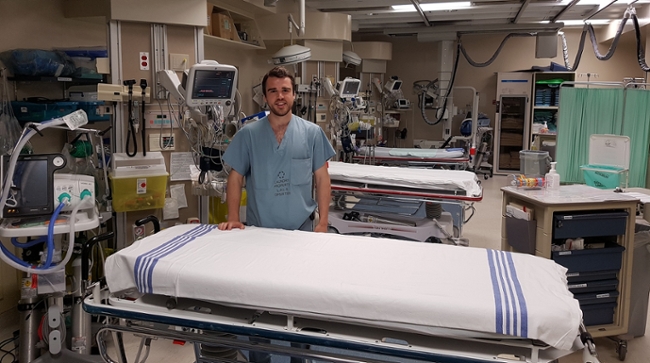The Reach of Trauma – Doctors Perspective

Dr. Patrick Murphy, General Surgery Resident in the Trauma Resuscitation Room at Victoria Hospital London
Trauma in children and teenagers can be overwhelming. Not only is it devastating to the young patient who was in a trauma such as a car crash but it is also challenging to be his or her parent, sibling, friend or part of the community. It is also overwhelming for the many trauma health care providers including paramedics, nurses, physiotherapists and physicians. As a resident physician in General Surgery, I have the privilege to be involved in Trauma in London and surrounding area for people of all ages, from newborns to those in the later stages of life.
The nature of trauma is that no one wakes up one morning and thinks, “I am going to be in a car crash today.” Trauma is unexpected and unanticipated, which is unique compared to most other diseases. It is not an event that happens over hours, although follow-up trauma care can last for years. Trauma is instantaneous and very much out of the blue. One minute you may be enjoying a summer drive to the beach and in less than a second, often through no fault of your own, your life inexplicably changes. Once you are brought to the hospital the lives of many people are influenced as well.
The reach of trauma is far; ask friends and family and it is almost certain they will either personally know someone who has been involved in a trauma, most commonly a car crash, or even may have been involved in one themselves. Often what is spoken about are the events surrounding the crash. If you have the opportunity, try asking about the hospital experience, in particular the interactions with care providers. Trauma is one of the most difficult experiences for hospital personnel: our patients are often a young healthy person in the prime of their life and easily relatable to. When a patient arrives to the trauma bay it is often organized chaos with 10-20 people performing various essential tasks from establishing intravenous access, given drugs, examining, and recording information. When trauma patients do not do well, the change in the room is palpable, the tension increases and time slows and seconds become minutes and minutes become hours. I remember each and every trauma patient who did not survive to hospital discharge and those who have died in the trauma bay.
One such example I think about often is a young teenage girl, who had just been in a fight with her boyfriend. She went for a walk to clear her mind and came to a crosswalk at a set of traffic lights. A driver at the same intersection could not see her at the cross walk and made a legal right turn, hitting this young girl in the process. When she came to the ER she lost her heart beat and we started CPR. CPR is extremely tiring and on average each staff performs CPR for 2 minutes before switching, CPR can go on for a long time. As part of the surgery team, we placed a tube in both side of her chest to see if she might have collapsed one or both lungs; she had not. We continued for what felt like hours but was likely only minutes, only a few correctable diagnoses cause the heart to stop in trauma patients. We continued to check for these correctable causes but unfortunately there was nothing we could do. Later that day I was present in the trauma bay when her mother arrived, she did not know what had happened. I will never forget her reaction or the sound of her voice when she asked why her daughter wasn’t breathing and why we were not doing anything.
The experience affected everyone in the emergency room and beyond that day. This young girl’s death rippled through her family, friends and her community. It also rippled through those trying to keep her alive.
Health care professionals must develop strategies to cope with the particularly tragic nature of trauma. We are fortunate to work with peers who understand the nature of trauma and offer support to each other through de-briefings, trust and friendship. More formally we are given the opportunity to discuss our trauma service at monthly rounds where the care of our patients is reviewed both to allow learning, but also closure. Finally, the appreciation of patients, friends and family even in the most heartbreaking traumas gives healthcare professionals the strength to continue.








